Tooting Bec Hospital
Tooting Bec Road, Upper Tooting, SW17 8BL
Medical dates:
Medical character:
Mental handicap, psychogeriatric
The fourth Asylum established by the Metropolitan Asylums Board (M.A.B.) was built to relieve the overcrowding in its other three Asylums at Leavesden, Caterham and Darenth.
A 28-acre site in Tooting Graveney, formerly part of the Tooting Lodge estate, was purchased in 1894 for £27,000. Construction work began in 1899, to the same design as the Leavesden and Caterham Asylums - two rows of ward blocks either side of a central administration building.The Tooting Bec Asylum opened in 1902, but the first 250 patients were not admitted until January 1903. Built on the block system, the Asylum had 1,000 beds and had cost just over £20,000 to build. The 3-storey ward blocks contained a 24-bedded ward on each floor. Each ward had steam heating as well as a double fireplace. The wards were equipped with Taunton Diagonal bedsteads; those for epileptic patients were 8 inches from the floor.
Nine ward blocks had been planned but only seven were built; there were four for female patients (instead of five) and three for males (instead of four). These blocks were connected to each other by long walkways, roofed in but not closed at the sides. Fire-escape bridges connected the first and second floors of each ward block to its neighbour, and these served as promenade decks or airing courts for the patients, or as verandahs for those who were bed-ridden to sit out on during fine weather.
The 4-storey central block contained offices and staff rooms, while a single-storey section at the rear contained storerooms, a laundry, domestic staff quarters, a boiler house, gas works and dynamo house. At the north of the site were two 3-storey Nurses' Homes.
The Asylum was designated to be used for infirm epileptics, patients with senile dementia and others 'requiring exceptional individual attention'. Its location at a less remote site had been chosen specifically so that its elderly inmates could be near family and friends.
The staffing ratio was one nurse to every five and a half patients. Unlike other mental hospitals at this time, there was no patient labour.
Originally it had been planned immediately to transfer patients from the three overcrowded Asylums, but in February patients from Colney Hatch Asylum had to be temporarily accommodated at Tooting Bec following a serious fire.
In 1906 the two ward blocks which had not been built in 1902 were added to the site. A recreation hall, which doubled as a chapel, was also erected between the laundry and the domestic staff quarters. A separate block was built on the eastern side of the site as a Receiving Home for children; this had a central 2-storey administration block and 5 single-storey ward blocks.
In 1914, just before the outbreak of WW1, M.A.B. decided to double the bed accommodation to 2200 beds. Bushey Down House, a large mansion to the southwest of the Asylum, was bought and demolished for the expansion. Building work ceased in 1916 because of the war, but resumed again in 1919.
In 1924 the first part of the extension was finished - four villas for female patients, containing two wards of 30 beds each on each floor. There were also 32 single rooms. The new blocks had verandahs on the ground floor and fire escape bridges on the upper floors. A Nurses' Home for 112 nurses was also built, and the recreation room and dining hall extended. In the same year the Asylum was renamed the Tooting Bec Mental Hospital.
The three 3-storey pavilions for male patients were completed in 1925. Each contained a single 36-bed ward on each floor. The Hospital then had 2230 beds and became exclusively used to house patients with senile dementia.
In 1930 it came under the control of the LCC, who built further extensions and, in 1937, renamed it Tooting Bec Hospital, dropping the word 'Mental' from its title.
In 1939 it had 2,355 beds.
It joined the NHS in 1948 under the control of the Tooting Bec Hospital Management Committee, part of the South West Metropolitan Regional Hospital Board.
In 1974, following a major reorganisation of the NHS, the Hospital came under the administration of the St Thomas' (Teaching) District Health Authority, part of the South East Thames Regional Health Authority.
In 1982, following yet another reorganisation of the NHS, it came under the authority of the West Lambeth District Health Authority.
Use of the Hospital had began to decline in the 1970s and in 1989 the site was put up for sale.
The Hospital closed in 1995 and services were transferred to St Thomas's Hospital.
Present status (March 2008)
Between 1996 and 1997 the Hospital buildings were all demolished and the site was redeveloped by Fairview Homes for residential use. It is now 'Heritage Park', a housing estate of about 600 dwellings, built at the cost of £42m. The site also contains a Medical Centre at the north and a nursing home in Church Lane.
Twenty metres of old wall remain at the northwest corner.
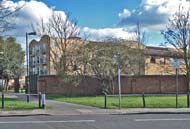
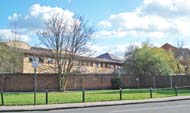
The old wall of the Hospital remains.
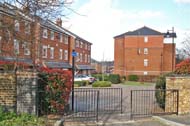
The entrance to the estate at the south.
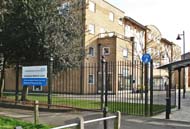
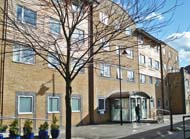
The Tooting Bec Medical Centre, part of the Sutton and Merton Primary Care Trust.
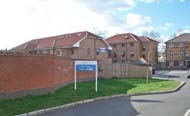
The Heritage Care Home owned by the Southern Cross Healthcare group.
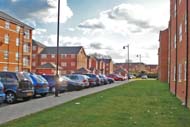

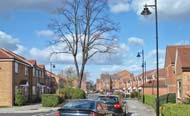
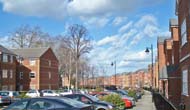
New housing on the former Hospital site.
Hunt EA 1903 The Eastern Counties' Asylum for Idiots, Imbeciles and the Feeble-Minded c.f. Some Similiar Institutions Elsewhere with Notes Upon the Question of Tuberculosis. Colchester, Eastern Counties.
Parsons CT 1908 Senile dements in London. British Medical Journal 2 (2501), 1720-1721.
Simmons S 1995 The History of Tooting Bec Hospital (unpublished material filed at the London Metropolitan Archives).
http://boroughphotos.org
http://disabilityrightsuk.blogspot.co.uk
http://discovery.nationalarchives.gov.uk
http://studymore.org.uk
https://britainfromabove.org.uk
https://langdondownmuseum.org.uk
https://mentalhealthengland.wordpress.com
https://twitter.com
www.art.com
www.countyasylums.co.uk
www.samappleby.demon.co.uk
www.swlondoner.co.uk
www.workhouses.org.uk
Return to home page